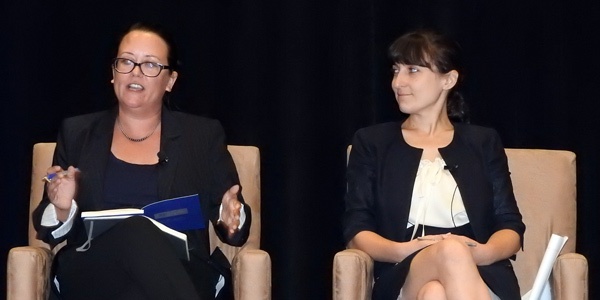By Rory D. Sweeney
CHICAGO — The growth of distributed energy resources and behind-the-meter innovation will require upgrades to the distribution network, speakers told PJM’s Grid 20/20 symposium last week.
While the innovative technology driving DER was the subject of much of the daylong conference, many speakers made sure to mention the more mundane network issues as well.
Often, the distribution and transmission networks are treated “as if they’re almost identical,” said the symposium’s keynote speaker, Michael Caramanis, a mechanical and systems engineering professor at Boston University. But a major advantage of the distribution network over the transmission network is that DER capabilities can allow it to sustain a much more competitive market, he said.
While distribution networks tend to experience more unusual situations on a regular basis — a condition described as “normal abnormalities” by CAISO’s Lorenzo Kristov — they also introduce greater marginal-cost granularity across the system, Caramanis said. Using distribution locational marginal pricing (DLMP), that granularity can be harnessed.
“That granularity, if it’s projected into management of distributed energy resource behavior … may affect the aggregate demand [seen] at the transmission and distribution interface,” he said.
“Right now, we’re in a period of evolution,” explained David Owens, the Edison Electric Institute’s executive vice president for business operations group and regulatory affairs. “The goal is to try to move more toward a market. … We have peer-to-peer transaction, but somebody’s got to see all of [the transactions]. Somebody’s got to provide that platform. Somebody’s got to manage it. There’s got to be visibility. There’s got to be interoperability standards. There’s got to be an integrated information and communication system. There’s got to be a data-exchange platform. We don’t have any of that today. … We’ve got a long way to go.”
DER Issues
“The obvious environmental benefits of distributed energy resources can be thought of as being blunted … by the inability to control renewable generation and by its volatility,” Caramanis said. “The way we reward and incentivize distributed energy resources — and, in particular, renewable generation — is introducing certain non-economical choices.”
Information privacy and what he termed as “computational complexity” are also concerns. “How do we handle billions of bits of information that characterize the preferences of millions of” customers? he asked.
That complexity extends to the network as well. “The distribution wires are in abnormal configuration all the time because there are so many circuits that keep changing,” Kristov said. Yet, communication and dispatching is between the grid operator and the resource owner, leaving the distribution-network owner uninformed about the situation.
With voltage changes of 5% able to damage appliances and cause brownouts, distribution networks require careful control, Caramanis said.
Utilities aren’t accustomed to the rapid changes DER may require, speakers said.
“Utility [information technology] systems are very cumbersome, closed and expensive to adapt,” said Kristin Munsch of the Citizens Utility Board.
“We don’t want to sit there and deploy something that we’re going to go back and regret and change a little bit later,” said Ben Kroposki of the National Renewable Energy Laboratory.
Agents of Change

And there is no guarantee that consumers will respond to market signals in the way economists would expect. “The one thing we know is people make uneconomic decisions all the time,” Munsch said. “We talk about these sort of transaction incentives and things we’re going to create with this underlying assumption that, ‘Well, all we have to do is explain it to them, and they’re going to be fine with it,’” she said. “Well, they’re not because on some level, utilities — whether it’s energy, natural gas, water — they are different. There’s an expectation they will be there when I want them, how I want them, at a price I can pay.”
Large-scale strategic companies are seeing ways to help with economies of scale, Marathon Capital’s Sarah Nash said. “A lot of these larger players who aren’t necessarily within the traditional energy space, they’re seeing ways to be able to supplement their offerings and move into the energy storage space,” she said.
On a more traditional level, local governments “are on the front lines of these things,” Owens said, and companies should “help them be ambassadors” of the system upgrades.
“Some get it; some fight it,” he said. The models are “smart cities” that have taken an active role in the process, he said.
“You’d be hard-pressed to find someone who says there isn’t overlap” between the state oversight of retail energy sales and the federal oversight of wholesale markets, FERC’s Jignasa Gadani said. “Is the new world going to be cooperative federalism? I don’t know how otherwise you move forward.”
Looking to the Future

The largest changes, however, might be in perception.
Kristov said the wholesale markets that developed in the late 1990s have created a “commodity concept” of electricity.
“I think we need to question whether that’s an adequate concept going forward because customers don’t care [about] kilowatt-hours; they care about services,” Kristov said. “The value of the grid used to be: get this commodity over here and move it over here, and that’s not the business of the distribution company anymore. It’s creating a new kind of network where the value may not be moving a commodity. It may be providing network services.”
Caramanis disputed that, saying the grid “essentially commoditizes the quality of service.”
“At the end of the day, in order for this to happen, the utility has to have the right incentives as well,” SolarCity’s Seyed Madaeni said. “We’ve got to have a paradigm shift and make sure all the incentives are aligned.”
Consolidated Edison’s Shelly Lyser added that properly valuing DERs’ environmental benefits also is important.







